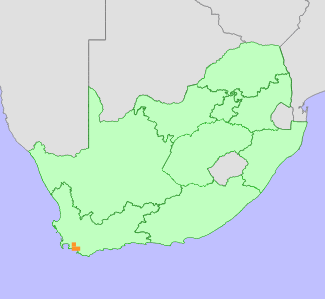|
Scientific Name | Serruria meisneriana Schltr. |
Higher Classification | Dicotyledons |
Family | PROTEACEAE |
Common Names | Dainty Spiderhead (e) |
National Status |
Status and Criteria | Endangered B1ab(i,ii,iii,iv,v)+2ab(i,ii,iii,iv,v) |
Assessment Date | 2020/06/30 |
Assessor(s) | A.G. Rebelo, H. Mtshali & L. von Staden |
Justification | Serruria meisneriana is a range-restricted species, with an extent of occurrence (EOO) of 140 km², and an area of occupancy (AOO) of 60 km². It is known from three locations that continue to decline due to habitat loss to agricultural crop expansion, alien plant invasion and too frequent fires. It therefore qualifies for listing as Endangered under criterion B. |
Distribution |
Endemism | South African endemic |
Provincial distribution | Western Cape |
Range | This species has a very limited distribution in the mountains of the Western Cape Province, South Africa, where it occurs on the Babilonstoring Mountains. |
Habitat and Ecology |
Major system | Terrestrial |
Major habitats | Overberg Sandstone Fynbos, Kogelberg Sandstone Fynbos, Western Coastal Shale Band Vegetation |
Description | It grows predominantly on shale bands, 100-500 m. Mature individuals are killed by fires, and only seeds survive. Seeds are released after ripening, and dispersed by ants to their underground nests, where they are protected from predation and fire. It is pollinated by insects. |
Threats |
| At least 18% of this species' habitat has been lost to agriculture (vines, cereals, pasture) in the past, and loss continues, with 2-10% loss recorded between 1990 and 2014. Its habitat on the Babilonstoring Mountains is infested with unmanaged alien invasive plants (hakeas and acacias), and it is threatened by habitat loss to expanding vineyards, crop cultivation and too frequent fire. |
Population |
Serruria meisneriana is known from four subpopulations. The Babylonstoring subpopulation extends over 15 km, and occurs in two patches. A large portion of this population has been lost to vineyard planting over the past 10 years. The Paardekloof subpopulation had several thousand plants spread over 6 km in 1992-2001, but a substantial portion of this subpopulation has been lost to planting of lavender and other essential oil crops between 2008 and 2015. At Kempsrivier, about 100 plants occurred over 1.5 km in 1996. This subpopulation has not recently been resurveyed. The Bot River subpopulations could not be re-located, despite extensive searches and is considered extinct. The population is declining due to ongoing habitat loss and degradation.
|
Population trend | Decreasing |
Assessment History |
Taxon assessed |
Status and Criteria |
Citation/Red List version | | Serruria meisneriana Schltr. | EN A2c; B1ab(i,ii,iii,iv,v)+2ab(i,ii,iii,iv,v) | Raimondo et al. (2009) | | Serruria meisneriana Schltr. | Rare | Hilton-Taylor (1996) | | Serruria meisneriana Schltr. | Rare | Hall et al. (1980) | |
Bibliography |
Goldblatt, P. and Manning, J.C. 2000. Cape Plants: A conspectus of the Cape Flora of South Africa. Strelitzia 9. National Botanical Institute, Cape Town.
Hall, A.V., De Winter, M., De Winter, B. and Van Oosterhout, S.A.M. 1980. Threatened plants of southern Africa. South African National Scienctific Programmes Report 45. CSIR, Pretoria.
Hilton-Taylor, C. 1996. Red data list of southern African plants. Strelitzia 4. South African National Botanical Institute, Pretoria.
Manning, J.C. and Goldblatt, P. 2012. Plants of the Greater Cape Floristic Region 1: The Core Cape Flora. Strelitzia 29. South African National Biodiversity Institute, Pretoria.
Raimondo, D., von Staden, L., Foden, W., Victor, J.E., Helme, N.A., Turner, R.C., Kamundi, D.A. and Manyama, P.A. 2009. Red List of South African Plants. Strelitzia 25. South African National Biodiversity Institute, Pretoria.
Rebelo, T. 2001. Sasol Proteas: A field guide to the proteas of southern Africa. (2nd ed.). Fernwood Press, Vlaeberg, Cape Town.
|
Citation |
| Rebelo, A.G., Mtshali, H. & von Staden, L. 2020. Serruria meisneriana Schltr. National Assessment: Red List of South African Plants version . Accessed on 2025/05/31 |
 Comment on this assessment
Comment on this assessment

